Prime Rib Cooking Times: A Comprehensive Guide
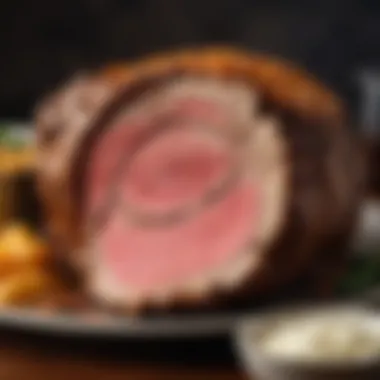
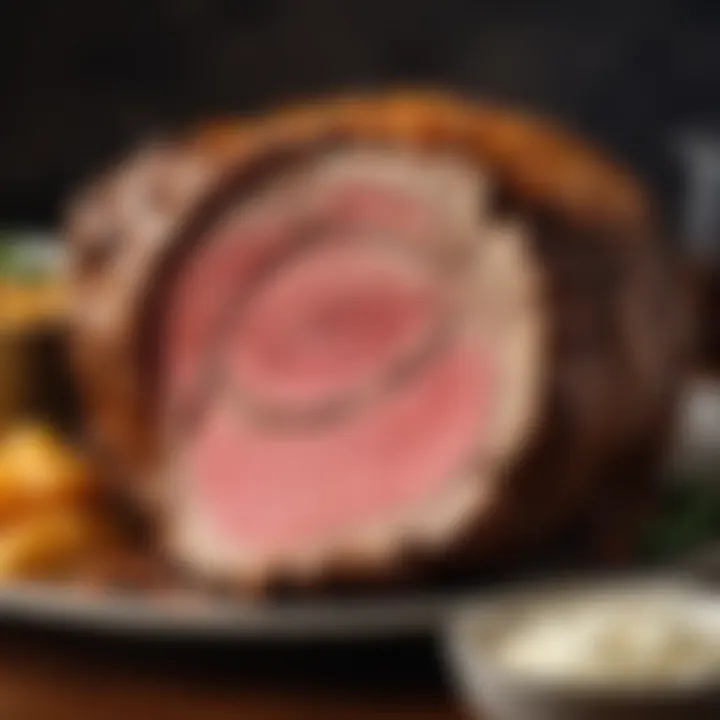
Intro
Cooking prime rib can be a daunting task for many, but it is also a rewarding experience. This delightful cut of beef is known for its rich flavor and tenderness, often highlighted during special occasions and family gatherings. Understanding cooking times is crucial for achieving that perfect medium-rare finish or whichever doneness you prefer.
Factors such as the size of the prime rib, cooking method, and temperature play pivotal roles in determining how long it needs to cook. This guide serves to demystify these aspects, providing you with a comprehensive understanding that can elevate your cooking skills.
As you read through this guide, you will learn about the intricacies of cooking prime rib, preparation methods, and effective techniques. This information is easily digestible for both novice and seasoned cooks. The goal is to equip you with sufficient knowledge to impress your guests with a juicy, flavor-rich prime rib, all while simplifying the cooking process.
Let us begin by discussing the recipe highlight, which lays the foundation for a memorable prime rib experience.
Prelude to Prime Rib
Understanding prime rib is more than just knowledge of a cut of meat; it is crucial for any cooking enthusiast. Prime rib represents a blend of flavor and tenderness that is hard to replicate with other cuts. Knowing how to prepare it correctly can transform an ordinary meal into a remarkable dining experience. This article will guide you through the key concepts related to prime rib cooking, emphasizing important factors that can influence the final dish.
Understanding Prime Rib
Prime rib, often referred to as standing rib roast, is a prized cut from the rib section of the cow. This cut is notable for its rich marbling, which enhances tenderness and flavor. The quality of the prime rib often differentiates it from other roasts. It is essential not only to choose a good cut but also to understand the various grades available, such as Prime, Choice, or Select. The USDA Prime grade indicates meat with abundant marbling and is considered the best available. For the utmost quality, select beef that has a bright red color, good fat distribution, and a firm texture. Utilizing prime rib in your cooking allows for both formal dinners and casual gatherings, making it a versatile choice.
Cut and Quality Considerations
The cut and quality of prime rib significantly impact the cooking process. First, one must decide on the cut one is interested in. The whole prime rib, which contains seven ribs, is often more suited for gatherings. However, purchasing a smaller cut, such as a three-bone roast, might be more manageable for small households. Furthermore, when considering the quality, be mindful of several factors:
- Marbling: Higher marbling generally means more flavor and tenderness.
- Age: Aged beef often provides enhanced flavor due to natural enzymatic processes.
- Appearance: Look for a bright, unmarred surface. Avoid cuts with excessive bruising or a dull color.
It is wise to consult your butcher regarding specific preferences. A knowledgeable butcher can assist in identifying the best options available. Ensuring high-quality cuts leads to satisfactory results that delight the palate.
Factors Influencing Cooking Times
Understanding the factors that influence cooking times is crucial for achieving the desired results when preparing prime rib. Each element plays a significant role in ensuring that the meat cooks evenly, maintains its tenderness, and reaches the preferred level of doneness. Acknowledging these factors can greatly enhance your cooking skills, leading to more satisfying outcomes. This section will delve into three main aspects that affect cooking times: the size of the roast, the oven temperature, and the resting time after cooking.
Size of the Roast
The size of the prime rib roast is one of the most critical factors affecting cooking times. Larger cuts naturally require more time to cook thoroughly compared to smaller ones. A standard rule of thumb is to allocate approximately 15 to 20 minutes of cooking time per pound at 325°F (163°C). However, this can vary with the method of cooking and individual oven performance. When selecting your roast, consider the following points:
- Weight: The greater the weight, the longer it will take to reach your desired temperature.
- Shape: Irregularly shaped cuts may cook unevenly, requiring more careful monitoring.
- Bone-in vs. Boneless: A bone-in roast typically takes longer due to the added mass of the bone.
Utilizing a meat thermometer is recommended to ensure the roast is cooked to the appropriate internal temperature. This enables cooks to better gauge when the meat achieves the level of doneness required.
Oven Temperature
Oven temperature is another significant aspect influencing the cooking time of prime rib. The higher the oven temperature, the faster the roast cooks. However, cooking at elevated temperatures can lead to uneven results, which might affect the tenderness of the meat.
For traditional roasting, a temperature range of 325°F (163°C) to 350°F (177°C) is ideal. Here are some considerations:
- Consistency: Keeping a steady temperature throughout the cooking process ensures even cooking.
- Initial Searing: Some prefer starting with a high heat to sear the exterior, locking in moisture before lowering the temperature for the remainder.
- Impacts on Flavor: Cooking at a lower temperature tends to enhance flavors as it allows the meat to marinate in its juices more effectively.
Resting Time Post-Cooking
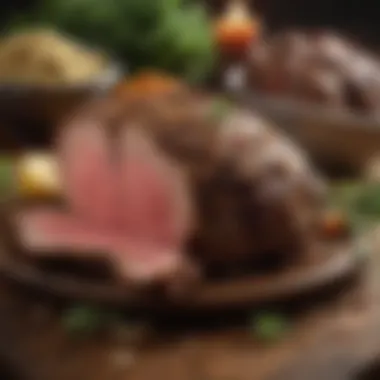
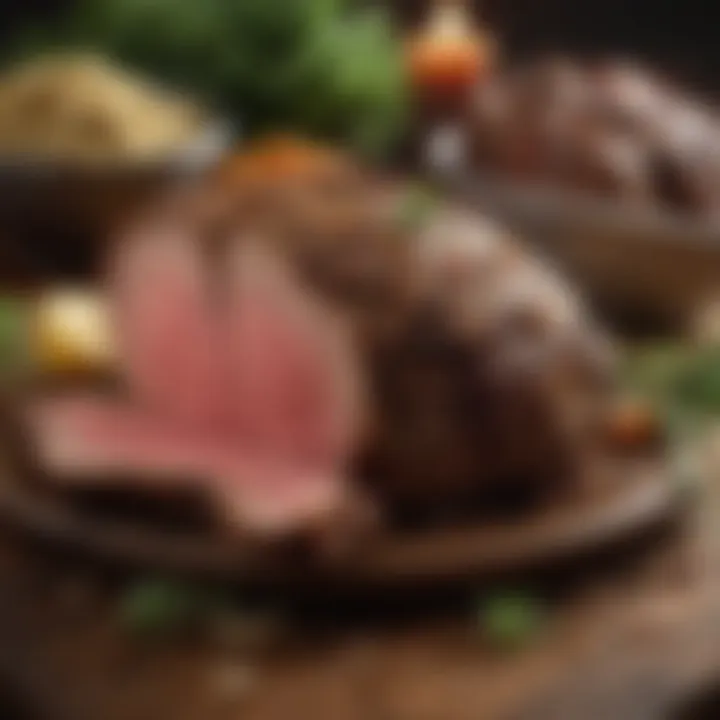
Resting the meat after it is removed from the oven is often overlooked, yet it is vital for prime rib preparation. Allowing the roast to rest before carving helps the juices redistribute throughout the meat, preventing them from running out when cut. Here are key points to consider:
- Duration: It is recommended to let the roast rest for at least 20 to 30 minutes. This can vary depending on the size.
- Covered: Tent the roast loosely with foil to retain warmth while resting.
- Impact on Doneness: The internal temperature can rise by as much as 5°F (2.78°C) during resting, which could lead to overcooking if it is not accounted for.
In summary, accurately gauging cooking times relies on understanding how various factors interact with one another. Size, temperature, and resting periods collectively contribute to achieving a perfectly cooked prime rib.
Cooking Methods for Prime Rib
Cooking methods for prime rib are essential to understand for any cook aiming to achieve that perfect blend of flavor and tenderness. The method you choose impacts not only the cooking time but also the overall texture and juiciness of the meat. Different techniques can yield distinct results, each bringing its own advantages and challenges to the table. Here we will explore three major methods: Traditional Roasting, Reverse Searing, and Sous Vide Cooking. Each method allows for adaptability depending on your available time and equipment.
Traditional Roasting
Traditional roasting remains the most classic method of preparing prime rib. This technique involves cooking the roast in a hot oven. Begin by preheating your oven to the desired temperature. A common recommendation is to roast at 450°F for the first 20 minutes to create a flavorful crust, then reduce the temperature to around 325°F to finish cooking it gently.
When roasting, using a rack will help circulate heat evenly around the roast. It is essential to monitor the internal temperature closely, using a reliable meat thermometer. Aim for an internal temperature of 130°F for medium-rare.
Benefits of traditional roasting include the development of a rich, caramelized surface and a deeply flavored interior. One should also be aware of potential downsides, like the risk of overcooking if the temperature is not monitored effectively.
Reverse Searing
Reverse searing has gained popularity due to its ability to produce a uniformly cooked and tender prime rib. This method is quite different from traditional roasting. In reverse searing, you start by cooking the prime rib at a low temperature, usually around 225°F until it reaches about 10-15°F below your target doneness.
After the initial phase, the roast is removed from the oven and allowed to rest briefly. A hot skillet is then used to sear the exterior, creating a delicious crust that enhances flavor. This technique prevents the common problem of having an overcooked exterior with a rare center.
Benefits of reverse searing include enhanced control over cooking, which minimizes the chances of overcooking your meat. The final sear adds a appealing texture that many enjoy. However, be prepared for a longer overall cooking time as low and slow methods require more patience.
Sous Vide Cooking
Sous vide offers a unique approach by allowing precision in temperature control. This method involves sealing the prime rib in a vacuum-sealed bag and immersing it in water at a consistent, low temperature, typically around 133°F for medium-rare. Cooking can take anywhere from 6 to 10 hours, depending on the thickness of the cut.
After cooking sous vide, it is necessary to finish the meat with a quick sear in a hot pan or on a grill to develop a crust. The sous vide process retains moisture and ensures consistent doneness throughout, making it an excellent option for those who struggle with traditional cooking methods.
The benefits of sous vide include the near elimination of cooking errors and higher flavor retention. However, this method requires specialized equipment and significantly more time than other methods.
In summary, exploring various methods of cooking prime rib reveals a range of possibilities, each suited to different tastes and situations. Depending on your preferences, time constraints, and available equipment, there is definitely a method that can yield exceptional results.
Prime Rib Cooking Times by Weight
Understanding cooking times by weight is crucial when preparing prime rib. This ensures that your roast is cooked to the desired doneness without becoming dry or undercooked. Cooking times vary depending on the weight of the meat. The more precise the timing, the better the outcome. It can help achieve a perfect balance of flavor and texture, giving your guests a truly delightful experience.
Calculating Cooking Time per Pound
Calculating cooking time per pound is a straightforward approach. A common guideline is to allocate approximately 15 to 20 minutes per pound at a temperature of 325°F (163°C) for medium rare. This estimation allows for a consistent cooking process while accommodating variables like oven efficiency and meat thickness. Using this formula permits flexibility. However, it is essential to remember that these times are not fixed. A meat thermometer is your best ally for accuracy in determining when the roast is ready.
Time Guidelines for Different Doneness Levels
Rare
Rare is often cherished for its tender, juicy texture. It requires a cooking time that usually ranges from 12 to 14 minutes per pound. The result is a deep red center that many steak enthusiasts appreciate. It is important to monitor the internal temperature closely because it can easily transition to medium rare if overcooked. One should be careful not to overestimate this cooking duration.
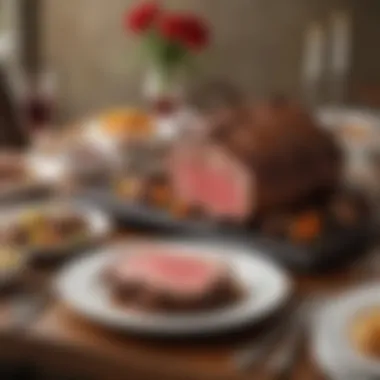
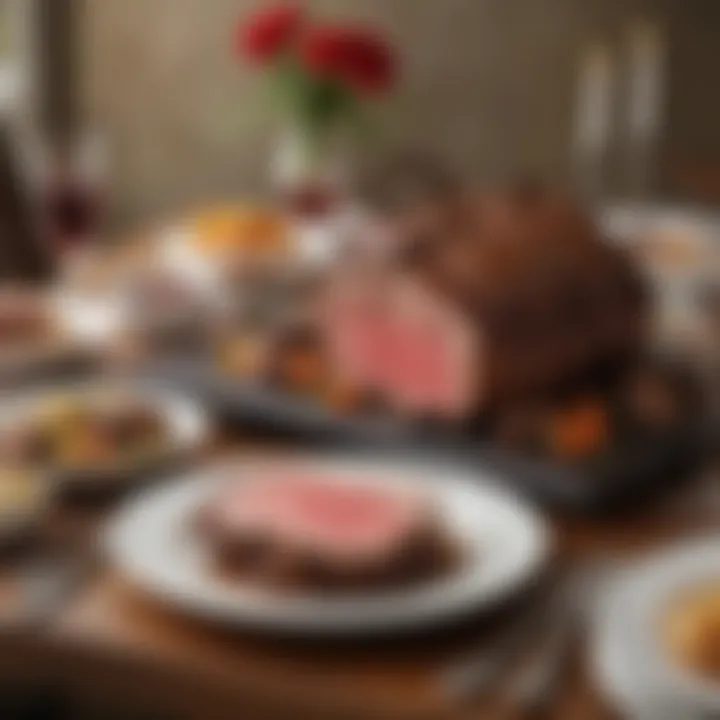
Medium Rare
Medium rare is a popular choice for a reason. It is recommended to cook for about 14 to 16 minutes per pound. This doneness showcases a warm red center, which enhances the flavor profile. This method retains moisture, adding to its palatability. Many cooks favor this for family gatherings or special occasions, as it strikes the right balance between flavor and texture, appealing to a wide range of preferences.
Medium
Medium provides a firmer texture with a pink center. For this doneness, allocate around 16 to 18 minutes per pound in the oven. The flavor remains rich, but the moisture content begins to decrease slightly. This option suits those who prefer their meat cooked through without compromising tenderness. However, one must be cautious, as overcooking can result in a less desirable, drier texture.
Medium Well
Medium well is not favored by everyone, but some appreciate its firmness. It generally takes about 18 to 20 minutes per pound. The meat will show a hint of pink, if any, in the center. This option is often sought by diners who prefer confidence in their meat's cook level. While this results in a more robust texture, it is crucial to ensure it does not end up dry or chewy, as it can be a common pitfall.
Well Done
Well done is for those who want no trace of pink, cooking for approximately 20 to 22 minutes per pound. This level is often considered less desirable among purists, as the moisture content and tenderness significantly decrease. The flavor, while still present, might not compare to the other levels. However, it can appeal to those who have specific preferences or dietary requirements.
"A well-cooked prime rib is a balance of time, weight, and patience."
Tools and Equipment for Cooking Prime Rib
Cooking a prime rib roast properly requires more than just good ingredients. The tools and equipment used in the process play a crucial role in ensuring that the meat is cooked to perfection. Using the right tools can greatly enhance the cooking experience and the final outcome.
Essential Kitchen Tools
To effectively prepare and cook prime rib, certain kitchen tools are essential. These tools can make the process smoother, more efficient, and better suited for achieving the desired doneness. Here are key items you should have on hand:
- Roasting Pan: A sturdy roasting pan is critical for holding the roast. Look for a pan with high sides to catch drippings and juices.
- Rack: A metal rack elevates the roast off the bottom of the pan, allowing for even cooking and better air circulation.
- Carving Knife: A sharp knife is necessary for seamlessly carving the roast into pieces. It helps in achieving even and clean cuts.
- Cutting Board: A large cutting board provides ample space for carving and serving.
- Tongs: Tongs are useful for handling the roast safely without piercing it, which maintains the juiciness of the meat.
- Serving Platter: A sizable platter is needed for presenting the beautifully cooked prime rib.
These tools not only assist in the preparation and cooking of the prime rib but also enhance the overall presentation.
Choosing the Right Thermometer
One of the most important aspects of cooking prime rib is ensuring that it reaches the desired level of doneness. A reliable meat thermometer is indispensable in this regard. There are various types of thermometers available, each with its properties and uses. Here are a few considerations when choosing one:
- Type of Thermometer: Digital instant-read thermometers are popular for their speed and accuracy. They can provide readings in seconds, making it easier to monitor doneness without losing heat by opening the oven door.
- Probe Length: Look for a thermometer with a long probe. This allows you to insert it deeply into the roast without touching bone, which could give inaccurate readings.
- Range of Temperatures: Ensure that the thermometer can measure the full range of temperatures needed for various doneness levels, from rare to well done.
- Calibration Feature: A thermometer that can be calibrated provides the best accuracy. This is especially important when cooking prime rib, as slight deviations can affect your results.
"The right thermometer makes a significant difference in achieving precision. It takes the guesswork out, ensuring your prime rib is cooked just right."
When equipped with the appropriate tools and a good thermometer, the cooking process becomes less daunting. It allows you to focus more on perfecting your technique and achieving the best possible flavor and tenderness for your prime rib.
Serving and Carving Prime Rib
Serving and carving prime rib are crucial steps that can significantly influence the overall dining experience. Even the most meticulously cooked roast can fall flat if presented poorly. Therefore, it is essential to pay attention to these aspects. Proper serving techniques highlight the meat's quality and enhance its visual appeal. Additionally, effective carving helps retain juices, ensuring optimal flavor and texture.
Resting the Meat
Before carving, it is vital to rest the prime rib after cooking. Resting allows the juices within the meat to redistribute, which prevents them from escaping when the roast is cut. Typically, let the roast rest for about 15 to 30 minutes, depending on its size. During this time, cover the meat loosely with aluminum foil to retain warmth.
The temperature of the meat can also rise slightly during resting, further enhancing the texture. This process transforms the prime rib from simply good to exceptional. If the meat is cut too soon, it may result in a dry and less flavorful roast.
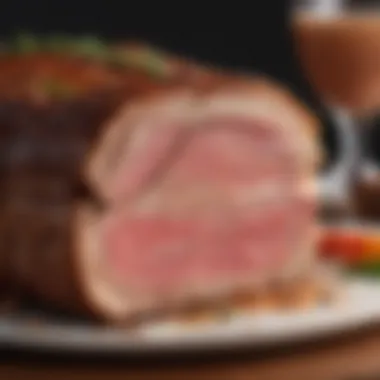
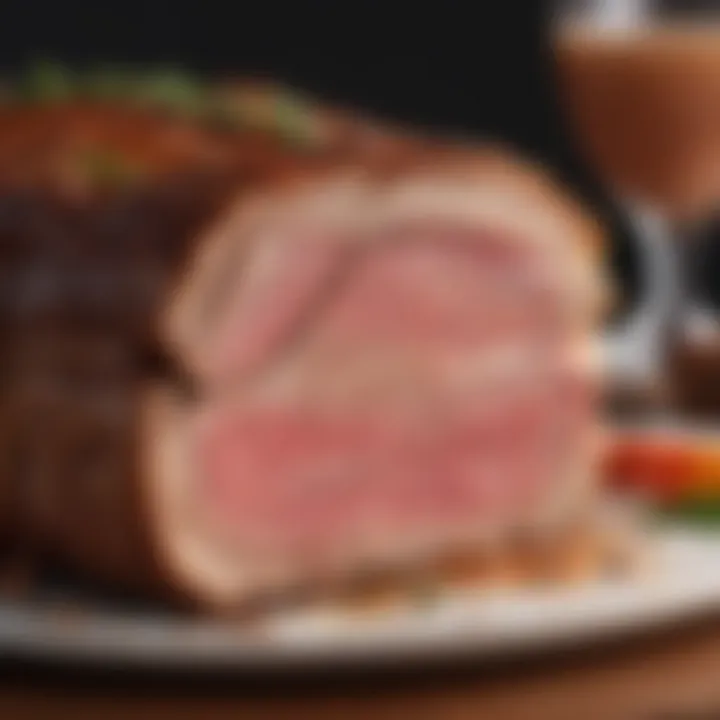
Techniques for Carving
Carving prime rib requires a specific technique to be done properly. Start with a sharp, long knife, preferably a carving knife. This type of knife allows for smooth cuts, ensuring clean and even slices.
- Identify the Bones: If you have a bone-in roast, begin by locating the rib bones. Carve along the bones to separate the meat.
- Angle Your Cuts: Hold the knife at a slight angle for each cut. This method helps create wider, more appealing slices.
- Thickness of Slices: Aim for slices approximately one inch thick. This size strikes a balance between presentation and ensuring each piece is juicy and easy to handle.
- Against the Grain: Pay attention to the direction of the muscle fibers and slice against the grain. This results in more tender pieces.
- Use a Carving Fork: A carving fork helps stabilize the roast while cutting, giving more control.
Effective carving is key to presenting a prime rib that looks as great as it tastes.
After carving, arrange the slices neatly on a serving platter. You can optionally drizzle some of the juices over the meat or serve with horseradish or au jus for added flavor. The way prime rib is carved and served can elevate the entire meal, making it memorable for you and your guests.
Common Mistakes to Avoid
Cooking prime rib can be an enjoyable experience, but various mistakes can ruin the end product. Recognizing common pitfalls enhances both the cooking process and the final flavor of the meat. Understanding these mistakes is crucial for both novice and seasoned cooks. Avoiding errors can elevate a meal from mediocre to memorable. Here are some essential elements to keep in mind as you cook your prime rib.
Overcooking and Undercooking Challenges
One of the primary challenges in cooking prime rib is achieving the desired level of doneness. Overcooking can lead to a dry and tough texture while undercooking may produce an unsafe dish that could lead to foodborne illnesses. A well-cooked prime rib should be juicy and tender, showcasing its rich flavors.
- Know the Target Temperature: Use a meat thermometer to check internal temperatures. Aim for:
- Resting Time Matters: After cooking, let the roast rest for at least 20-30 minutes. This allows the juices to redistribute, making for a more flavorful cut.
- Rare: 125°F (52°C)
- Medium Rare: 135°F (57°C)
- Medium: 145°F (63°C)
- Medium Well: 150°F (66°C)
- Well Done: 160°F (71°C)
Remember, factors like oven calibration and roast size can change cooking times. Keep an eye on it and adjust accordingly.
Using Improper Tools
Another common mistake is not using suitable tools for the task. Understanding the right equipment for cooking prime rib can significantly affect the outcome. Using improper tools can lead to errors in cooking times or meat quality. Here are key tools you should consider:
- A Reliable Meat Thermometer: A digital instant-read thermometer is preferred to ensure precise temperature readings.
- Roasting Pan: A heavy-duty pan ensures even heat distribution. Avoid pans that might warp or are too small, impacting cooking time and heat retention.
- Cutting Knife: A sharp carving knife simplifies the slicing process and produces clean cuts without tearing the meat fibers.
Utilizing the right equipment helps sidestep many challenges, leading to a more successful prime rib.
"Preparation and proper tools can transform the cooking experience, turning potential mistakes into culinary triumphs."
By being aware of these common mistakes, cooks can approach prime rib preparation with the knowledge needed for success. Each step requires focus, ensuring that your prime rib stands out as a centerpiece for any occasion.
Culmination
In the realm of culinary pursuits, understanding how to cook prime rib is not just an art; it is a science that requires knowledge and precision. The conclusion of this comprehensive guide underscores the importance of mastering prime rib cooking times. By aligning your cooking approach with the factors that influence these times, you can significantly elevate the quality of the dish served.
Important elements include knowing your roast's size, the precise oven temperature, and ensuring appropriate resting time. Each factor contributes to achieving the perfect doneness, whether you prefer it rare, medium rare, or well done. Through this understanding, the benefits are clear. You not only enhance the flavor and texture of prime rib but also minimize the risks of common pitfalls, such as overcooking or undercooking your meat.
Additionally, choosing the right cooking method plays a vital role. Traditional roasting, reverse searing, or sous vide each brings unique advantages. Carefully evaluating these methods in relation to your schedule and desired outcome will provide a valuable framework for future meals. Ultimately, proper preparation fosters confidence in the kitchen, ensuring each prime rib you cook becomes a memorable centerpiece for any gathering.
Recap of Key Points
When looking back on the details of cooking prime rib, several key points emerge:
- Understanding Cooking Times: Different weights and desired doneness levels dictate varying cooking times. A precise grasp of these guidelines can prevent culinary mishaps.
- Temperature Control: The importance of maintaining the right oven temperature cannot be overstated. It significantly impacts the overall cooking process and final product.
- Resting After Cooking: Allowing the meat to rest post-cooking is essential for ensuring juiciness. This step enhances the overall dining experience.
- Common Mistakes: Being aware of overcooking, undercooking, and the use of incorrect tools can save your prime rib from less than optimal results.
Encouragement for Future Cooking
As you reflect on the nuances of prime rib cooking, consider this guide as a stepping stone toward culinary excellence. Each roast is an opportunity to practice and refine your skills. Experimenting with different methods and doneness levels will enhance your understanding and enjoyment of cooking.
Moreover, engaging with communities, such as forums on reddit.com or cooking pages on facebook.com, can provide ongoing support and inspiration. Failure is often part of the learning journey; embrace it. Every attempt will bring you closer to mastering the art of prime rib cooking. Stay curious and motivated, and soon enough, your kitchen will be the heart of remarkable meals.







